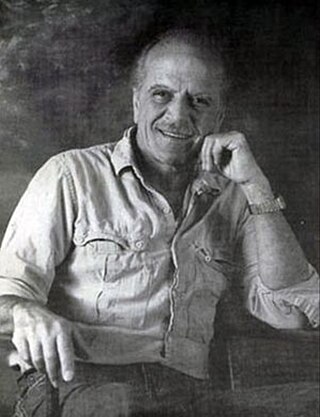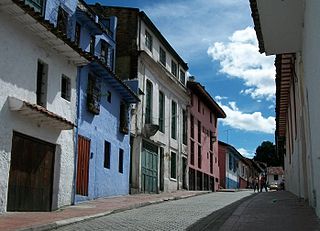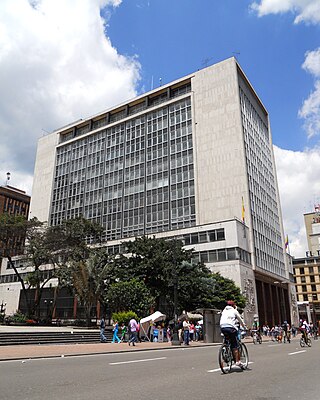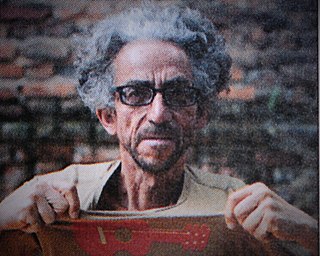
Santiago de Cali, or Cali, is the capital of the Valle del Cauca department, and the most populous city in southwest Colombia, with 2,227,642 residents according to the 2018 census. The city spans 560.3 km2 (216.3 sq mi) with 120.9 km2 (46.7 sq mi) of urban area, making Cali the second-largest city in the country by area and the third most populous after Bogotá and Medellín. As the only major Colombian city with access to the Pacific Coast, Cali is the main urban and economic center in the south of the country, and has one of Colombia's fastest-growing economies. The city was founded on 25 July 1536 by the Spanish explorer Sebastian Belalcazar.

The Museum of Gold is an archaeology museum located in Bogotá, Colombia. It is one of the most visited touristic highlights in the country. The museum receives around 500,000 tourists per year.

Colonia Roma, also called La Roma or simply, Roma, is a district located in the Cuauhtémoc borough of Mexico City just west of the city's historic center, and in fact is no longer a single colonia (neighbourhood) but now two officially defined ones, Roma Norte and Roma Sur, divided by Coahuila street.

Rodolfo Abularach was a Guatemalan painter and printmaker of Palestinian descent.

The Museo Casa de Moneda is a numismatics museum located in La Candelaria neighborhood of Bogotá, Colombia. It is managed by the Bank of the Republic of Colombia and used to display its numismatic collection that is composed by around 18,600 objects that include artwork, banknotes, bonds, coins, derivatives, medals, negotiable instruments, and printing instruments from various time periods and regions of the world.

La Candelaria is the 17th locality of Bogotá, Colombia. A historic neighborhood in the city's downtown, it is the equivalent to the Old City in other cities. The architecture of the old houses, churches and buildings has Spanish Colonial Baroque, and art deco styles. It houses several universities, libraries and museums.

The Bank of the Republic is the central bank of Colombia. It was initially established under the regeneration era in 1880. Its main modern functions, under the new Colombian constitution were detailed by Congress according to Ley 31 de 1992. One of them is the issuance of the Colombian currency, the peso. The bank is also active in promoting financial inclusion policy and is a leading member of the Alliance for Financial Inclusion.
Luis Camnitzer is a German-born Uruguayan artist, curator, art critic, and academic who was at the forefront of 1960s Conceptual Art. Camnitzer works primarily in sculpture, printmaking, and installation, exploring topics such as repression, institutional critique, and social justice.
Emilio Sanchez (1921–1999) was an American artist known for his architectural paintings and graphic lithographs. His work is found in the permanent collections of the Metropolitan Museum of Art, Museum of Modern Art, National Gallery of Art, Smithsonian American Art Museum, Museo Nacional de Bellas Artes de La Habana, Bogotá Museum of Modern Art, La Tertulia Museum, and the National Gallery of Australia.

Antonio José Caro Lopera was a Colombian conceptual artist who created works since the late 1960s. He typically used non-traditional forms to create politically and socially charged critiques of Colombian issues. He died in Bogotá on 29 March 2021, aged 70.

Danilo Dueñas, has been a professor at the Art Department of the University of The Andes, the School of Fine Arts of the National University of Colombia and at the Faculty of Fine Arts of the Jorge Tadeo Lozano University since 1990. In 1995, he participated in the exhibitions Mesótica and Transatlántica, curated by Carlos Basualdo at the Museum of Contemporary Art and Design in San José de Costa Rica and the Alejandro Otero Museum of Visual Arts in Caracas, respectively. In 1999, he was the recipient of the Johnnie Walker in the Arts Award granted by Paulo Herkenhoff, for his installation "Espacio Preservado II", presented at the Luis Ángel Arango Library. In 2001, two simultaneous retrospective exhibitions of his works were held at the Museum of Modern Art in Bogotá and the Museum of Art of the National University of Colombia. In 2003, another retrospective exhibition was held at the Museum of Contemporary Art of Caracas. In 2006, he was the international guest at the Caracas FIA and in 2008 he presented "Dentro del espacio expositivo" at Periférico Caracas, curated by Jesus Fuenmayor. His works are also represented in the Museum of Fine Arts in Caracas and the Museum of Modern Art in Rio de Janeiro. He is now part of the Artist Pension Trust Mexico. During the year 2011, Danilo Dueñas was a guest of the Artists-in-Berlin Programme of the DAAD.

Feliza Bursztyn was a Colombian sculptor.

The Eduardo Sívori Museum of Plastic Arts is a municipal art museum in Buenos Aires, Argentina. It was named after painter Eduardo Sívori and was inaugurated in 1938.

Museo Universitario de Artes Populares María Teresa Pomar is a museum dedicated to Mexico's handcrafts and folk art tradition, called “artesanía.” It is part of the University of Colima in the city of Colima, founded by artesanía collector and promoter María Terea Pomar. It contains one of the most important collections of its type in Mexico, covering traditions from around the country as well as the artesanía and traditions of the state of Colima.

The Museo Botero, also known as the Botero Museum, is an art museum located in La Candelaria neighborhood of Bogotá, Colombia. It houses mostly works by Colombian artist Fernando Botero, however it also includes artwork by other international artist that were of Botero's own private art collection.
Miguel Ángel Rojas is a Colombian conceptual artist born in Bogotá in 1946. His work includes drawing, painting, photography, installations and video and is often related to the sexuality, the marginal culture, the violence and problems involved with drug consumption and production.

Oscar Muñoz is a Colombian visual artist. He is known as one of the most significant contemporary visual artists in his country, and his work has also gained international recognition. Most of his art is concerned with the idea of representation, and his choice of art medium moves freely between photography (photorealism), printmaking, graphite drawing, installation art, audiovisual media, and sculpture. He also explores how images relate to memory, loss, and the precarious nature of human life.

Ruby Rumié is a Colombian artist. She studied at the School of Fine Arts of Cartagena de Indias and the David Manzur Academy in Bogotá. She has exhibited around the world in places such as Colombia, Chile, the United States of America and France.
Karen Lamassonne is a Colombian American artist. Throughout her career Lamassonne has explored a plethora of disciplines such as film, printmaking, painting, graphic design, video art, and music. Lamassonne’s work is notable for reflecting this combination of several different studies, most noticeably that of her paintings having a very cinematic vision behind them. Noteworthy works of Lamassonne’s all contain this sense of multifaceted technical skills put into them. A majority of Lamassonne's work contains motifs of sensuality from a woman's perspective, specifically she includes sexuality from her own perspectives and experiences. Moreover, her signature combination of feminine-led sexuality and a frank expression of true life have led to both Lamassonne and her work being the subject of criticism via censorship.

Hernando Tejada Sáenz, popularly known as Tejadita, was a Colombian painter and sculptor. His most well-known sculpture, El Gato del Río, is a famous landmark of Cali, Colombia.





















